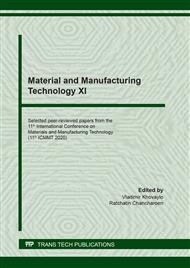p.9
p.15
p.21
p.27
p.34
p.40
p.49
p.55
p.61
Effect of Modified Silica Fume and Cellulose Fiber Used as Fillers on Properties of Antivibration Rubber
Abstract:
The effect of modified silica fume (mSF) and cellulose fiber (CF) content on the cure characteristics, mooney viscosity, mechanical, durability and heat resistance properties are investigated; as compared with SF and unfilled natural rubber. From the results reveal that mSF and CF affect not only fast cure rate, high viscosity but also improve rubber mechanical and heat resistance properties. Additionally, the mSF and CF are added into the natural rubber to produce antivibration rubber product and then study the rubber product performance such as durability properties. The mSF and CF effective in improving the crack resistance of antivibration rubber product more than SF and unfilled natural rubber which is due to enhancing the stiffness. The all obtained results, it can be proved that mSF and CF as the new alternative fillers in rubber industry.
Info:
Periodical:
Pages:
34-39
Citation:
Online since:
February 2021
Authors:
Keywords:
Price:
Сopyright:
© 2021 Trans Tech Publications Ltd. All Rights Reserved
Share:
Citation:


